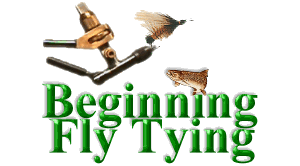 Part Nine |

 Part Nine |

By Al Campbell
|
 |
|
|
|
For the first fly we'll use:


|
|

 When you dub a body, select half the amount of dubbing you think you will need, cut that in half, and then you'll only have twice as much dubbing as you need to twist around the thread. Keep the dubbing sparse and add more as needed. Dub the body to the same point you wrapped the no-dub. Finish the rest of the fly in the same manner you did the last one.
|
|
 Dub a thin body to the same place on the hook as before. Pull the hair over the back and finish the fly as before. Notice the different color the badger hair provides? Changing where you select the hair from on a skin or tail will often change the color or shade of the hair and the resulting fly.
 For instance, I tie a Shwapf with a pearl Krystal flash back and hackle, and a peacock body to imitate backswimmers (water boatman), those little aquatic bugs that look like they have oars on the sides of their bodies. I also use glass beads and dubbing to create flies that work as egg and flesh fly imitations.
|